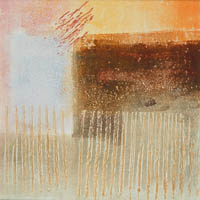About Monotype, Giclée, and Cards
What is a monotype?
The artist roles or brushes a design in printing inks on a smooth plate or sheet of glass and transfers it to a sheet of paper by running it through an etching press while the ink is still wet. The process was invented by Giovanni Beneditto Castiglione in the 1640's. It was revived in the 19th century, notably by Degas and continues to appeal to artists for the remarkable effects that can be obtained. Only one strong impression can be made by this process, hence its name, but sometimes a second, weaker impression is also printed. The second impression is very different from the first. There are no multiple copies of original monotypes. KC roles top quality printer’s inks onto Plexiglas, adds and subtracts inks until the image feels “right,” then prints the image on Arches 88, a conservation quality paper made in France, using a large Takach etching press.
What is a Giclée Print?
Pronounced "zhee-clay" French for "to spray," giclée is the term commonly used for what is currently the most advanced digital fine art reproduction technology (first done in the early 1990s). Images are generated from high-resolution digital scans or photographs and printed with archival quality inks on acid-free paper with an enhanced printer, specially modified for fine art reproduction. The giclée printing process provides better color accuracy than other means of reproduction.
KC’s limited edition Giclée prints are signed and numbered. Both the inks and papers used in the process are fine art museum quality. All prints whether limited edition or not are Giclée quality.
Fine Art Greeting Cards
Some of KC’s original images are also available in greeting card format. The Giclée digital image is used to create an excellent rendition of the image. All cards are blank inside and can be used for any occasion. The size and orientation of the card varies according to what will work best for that image.
